
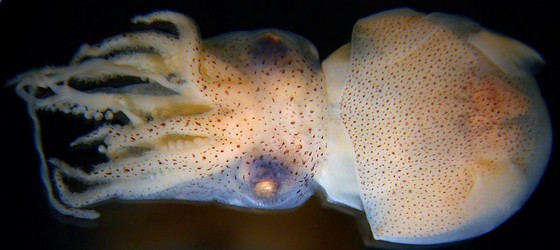
Figure. Dorsal view of New Species A, holotype, 9.5 mm ML. Photograph by R. Young.
Characteristics
- Arms
- Arms IV with globular suckers in two series throughout.
- Arms I-III with 8 large suckers on each arm base abruptly giving way to multiple series of tiny suckers on long stalks.
- Large arm suckers with circularis muscles.
- Most proximal arm sucker not distinctly larger than following sucker.
- Low aboral web between arms I, arms I and II, and arms II and III; deep web between arms III and IV.
- Low oral web between arms III and IV.
- Tentacles
- Each club with 11 suckers in two series on distal portion of club; proximal portion with folded, semilunar keel.
 Click on an image to view larger version & data in a new window
Click on an image to view larger version & data in a new window
Figure. Oral view of tentacular club of New Species A. Top - Photograph with transmitted light. Bottom - Photograph with reflected light. Photographs by R. Young.
- Head
- Eyes with corneas.
- Eyes without secondary eyelids.
- Anterior eye pore present.
- Olfactory organ lies in a pocket.
- Funnel
- Funnel without lateral adductor muscles.
- Presence of funnel valve uncertain. Oval pad present where funnel valve should be.
- Funnel component of the funnel/mantle locking-apparatus with simple, straight groove.
- Mantle component of the funnel/mantle locking-apparatus with simple, straight ridge that extends to the mantle margin.
 Click on an image to view larger version & data in a new window
Click on an image to view larger version & data in a new window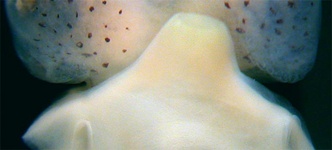

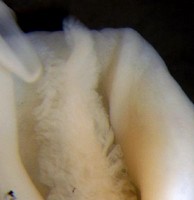
Figure. New Species A. Left ventral view of the funnel showing absence of lateral funnel adductor muscles. Middle - Frontal view of the funnel locking-apparatus. Right - Frontal view of the mantle locking-apparatus. Photographs by R. Young.
- Funnel without lateral adductor muscles.
- Fins
- Fins laterally rounded and with anterior and posterior lobes.
 Click on an image to view larger version & data in a new window
Click on an image to view larger version & data in a new window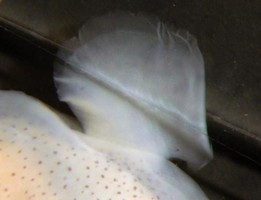
Figure. Ventral view of the right fin of New Species A showing anterior and posterior lobes. Part of the anterior lobe (right side in photograph) is partially folded under the fin. The edge of a glass slide is seen across the fin. Photograph by R. Young.
- Fins laterally rounded and with anterior and posterior lobes.
- Gladius
- Gladius not examined.
- Gladius not examined.
- Pigmentation
- Mantle, most of head, aboral surfaces of arms covered with numerous small but non-overlapping reddish-brown chromatophores.
- Oral surfaces of arms without chromatophores.
- Ventral midline of head without chromatophores.
- Chromatophores absent from region of nuchal head/mantle fusion.
- Chromatophores present on tentacular clubs and short region proximal to clubs but remainder of club apparently bare.
- Funnel without chromatophores.
- Viscera
- Penis appears to arise from open genital pocket or deep, circular fold in lining of mantle cavity.
- Branchial canal in gill apparently absent; gill segment not removed for confirmation.
 Click on an image to view larger version & data in a new window
Click on an image to view larger version & data in a new window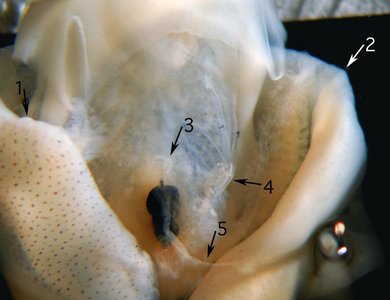
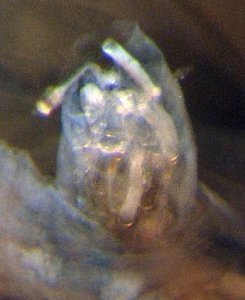
Figure. New Species A. Left - Ventral view of the mantle cavity. 1, 2 - Right and left mantle components of the funnel/mantle locking-apparatus. 3 - Anus, 4 - Penis, 5 - Ventral mantle adductor muscle. Right - Ventral view of the penis emerging from, apparently, the genital pocket and filled with spermatangia. Photographs by R. Young.
- Measurements and counts
1Total length of club.Sex Mature male Mantle length 9.5 mm Mantle width ca. 8 mm
Head width 8.1 mm Head length 5.3 mm
Eye diameter ca. 3.2 mm Fin length 3.8 mm Fin width 2.9 mm
Arm I, length 7.0 Arm II, length
8.0 Arm III, length
~10 mm
Arm IV, length
9.2 mm Tentacle length 17 mm Club length 2.0 mm1, 0.6 mm2 Web depth, sector A, B 0.8 mm Web depth, sector C
1.5 mm Web depth, sector D
2.4 mm
2Length of sucker-bearing region of club.
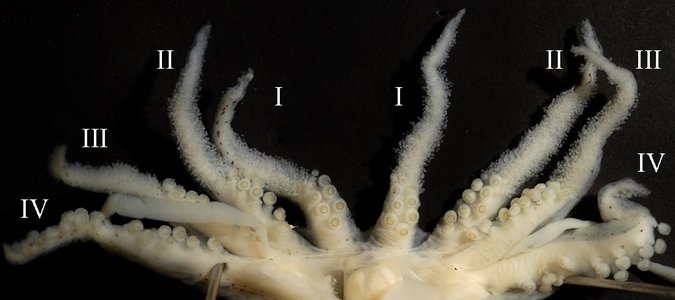
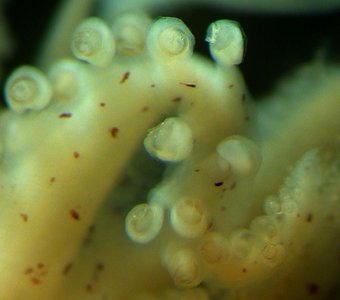
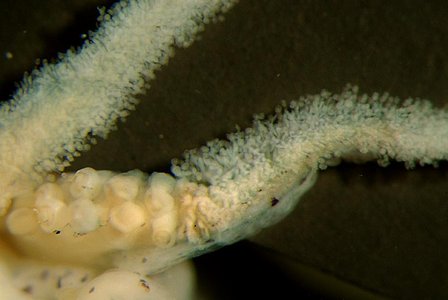
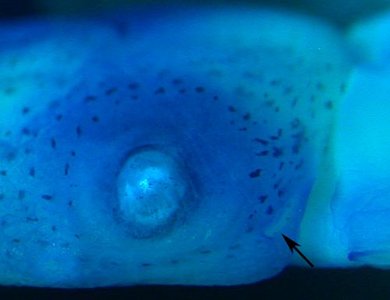




 Go to quick links
Go to quick search
Go to navigation for this section of the ToL site
Go to detailed links for the ToL site
Go to quick links
Go to quick search
Go to navigation for this section of the ToL site
Go to detailed links for the ToL site